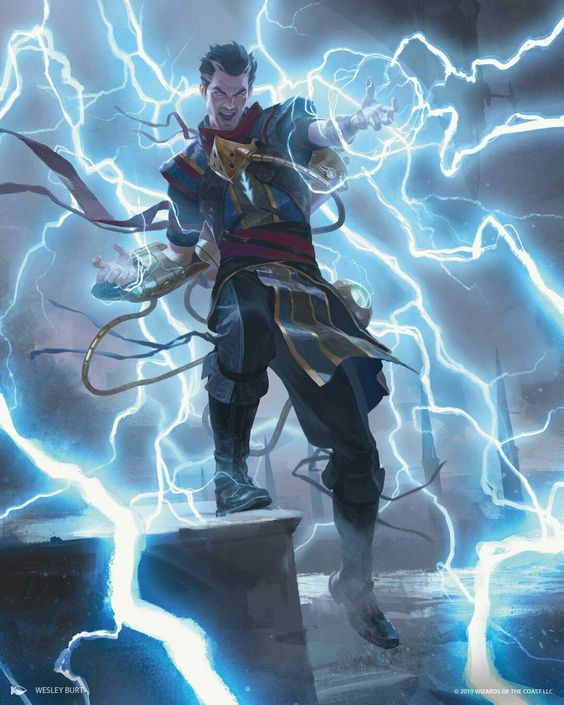D&D 5e: Become The Avatar of Elemental Forces With Elemental Adept

D&D 5e: Become The Avatar of Elemental Forces With Elemental Adept
SOURCE: Player’s Handbook
Rating the Benefits of Elemental Adept
Benefit #1 –
Choose a damage type from Acid, Cold, Fire, Lightning, or Thunder.
Spells you cast ignore resistance to that type of damage.
Anything that has resistance to a damage type cuts their damage taken in half. As characters level, resistances become far more common, and for a character who specializes in a specific type, being able to ignore it becomes almost essential.
Benefit #2 –
Spells cast in your chosen damage type also treat any rolls of 1 on the damage dice as a 2
Many blast spells roll a whole pile of dice and hit multiple targets. A boost to damage, especially on bad rolls, is incredibly welcome, especially since this can be used every single turn without limit.

Mechanics and Requirements
Understanding How Elemental Adept Functions
Damage resistance and damage types
Resistance is a surprisingly common defensive ability in D&D 5e, especially as characters level and climb up through power tiers.
Its function is incredibly simple to understand. If you have resistance against a source of damage, you only take half of the damage, rounded down.
So a hit that would do 20 damage does 10.
This is a significant hit to a character’s DPS, especially for characters who choose to specialize in specific damage types and don’t have good options for dealing damage outside of this type. (Hint. Don’t do this. Always have at least one effective means of dealing damage outside of your normal type.)
There are hundreds of monsters with elemental resistances spread throughout 5e’s sourcebooks, without mentioning the multitude of ways that humanoid characters can gain resistances: (Racial traits, spells, class abilities, magic items…)
Elemental Adept fixes this issue. When you choose the feat, you choose a damage type, from the list of Acid, Cold, Fire, Lightning, and Thunder.
Any damage the character now deals using spells ignores resistance to that damage. No roll is needed. No check to punch through damage reduction. Full damage is dealt. No questions asked.
That’s a powerful ability, especially for the most common damage types, which tend to have a similarly high amount of monsters with resistance to that damage.
Damage immunities
Be warned that instead of resistance, some monsters will have damage immunity, reducing all damage of a certain type to 0.
While damage immunity is far rarer than resistance, Elemental Adept does nothing against it. Monsters with immunity will still take 0 damage from a character with this feat
Boosting damage numbers
The secondary feature of the Elemental Adept feat is the ability to treat every damage dice of a 1 rolled by a spell in your chosen element as a 2 instead.
Any boost to DPS is always useful, but is this good? Let’s take a look at the numbers.
Fireball is possibly the most stereotypical damage spell in 5e. It deals 8d6 damage in a reasonable radius. When rolling damage for an AOE spell in 5e, you roll the dice once and apply that damage to every target in range.
The average damage from an 8d6 Fireball is 28, halved on a successful save. Of the 8 dice rolled, 1.3 of them will be 1s on average. This means the average damage of a Fireball powered by Elemental Adept increases from 28 to 29.3.
That doesn’t sound like a lot. Because it isn’t. But that’s not the whole story.
A fireball hits multiple targets, and that extra 1.3 damage is applied to each target. Hit 4 targets and suddenly the bonus damage ramps to 5.2, a much more reasonable amount.
It’s also worth considering two more things:
- A character built to use Elemental Adept should be gaining this damage every single turn, as the majority of their spell list is going to be focused around a single element
- Elemental Adept acts as insurance on the turns where the dice gods laugh in your face, and half the dice rolled show a 1.
Overall, while you might only see an average round-by-round DPS increase of 1 damage from this feat, over the 10-15 combat rounds an average party might face over a day, it adds up fast.
Key Stats
The Elemental Adept feat doesn’t provide any stats to a character but will require a character to boost their casting stat to stay competitive in attack rolls and save DCs.
Ideal Characters for Elemental Adept
Top Classes
Sorcerer – Blasters beyond compare with a spell list packed with damage spells, Sorcerers would already be the perfect user of the Elemental Adept feat, even without one key piece of the puzzle.
Transmuted Spell metamagic. This allows the character to shift the damage type of a spell, for the cost of a single Sorcery point, meaning every single spell a character casts can qualify for the feat and its bonuses.
For further boosts, roll Draconic Bloodline to add even more damage to spells of a particular element, plus some nice defensive boosts.
Genie Warlock – The Warlock is already a spellcaster that can throw down huge damage numbers, multiple times per day.
The Djinn subclass leans into that aspect of the build, stacking a pile of elemental spells into the Warlock list, plus bonus elemental damage on top of every spell the character casts. Even better, this bonus damage qualifies Eldritch Blast for the damage rerolls of the feat.
Evocation Wizard – The Evocation school of the Wizard class focuses on damaging elemental spells and boasts the most extensive spell list in the game.
In the mid-levels, the subclass gains a damage boost, but the big draw is Sculpted Spells, which allows the Wizard to treat areas in the middle of their biggest blasts as if they weren’t getting hit. Yes, this means you can safely drop a Fireball into the midst of a chaotic, swirling melee and deal zero damage to all of your allies.
Race or Subrace Choices
Fairy – While the Fairy does nothing to directly impact a character’s spellcasting prowess, the race comes with permanent, at-will flight, making it much easier to both find targets and get out of trouble when enemies look your way.
Eladrin – The main ability of the Eladrin race is a bonus action teleport that’s functionally identical to Misty Step until level 3, where it gains an added effect and gets stronger. Being able to teleport into or out of combat without impacting action economy or the ability to cast spells is massive on a primary spellcaster.
Genasi – Elemental people for an elemental spell. All Genasi come with a list of elemental spells they can cast once per day, plus Darkvision and some supplementary benefits. Our choice would be Air, as the spell list has fantastic utility for any spellcasting class.
Combos, Tactics, and Synergies
Complementary Feats
Metamagic Adept – Any class that doesn’t get Transmuted Spell can pick this up to shift damage types twice per day. Pick up another metamagic choice into the bargain.
Alert – Blast mages want to go first, to drop their damage before enemies get to act, and when they’re most likely to be clumped together. The Alert feat’s large +5 bonus is one of the biggest bonuses to initiative in the game.
Spells that Synergize
Fireball – The staple D&D damage spell. 8d6 damage in a large radius for a level 3 spell slot is a fantastic value, and Elemental Adept solves the resistance issue. Almost any problem can be solved with the judicious application of fireball.
Call Lightning – Less instant damage for more ongoing, Call Lightning deals a surprisingly hefty 3d10 damage every turn to every creature within 5ft of a point, which adds up over several turns, especially if enemies are corralled together so you can hit multiple.
Scorching Ray – Possibly the best level 2 damage spell in the game, Scorching Ray fires a volley of 2d6 damage beams that heavily benefit from the reroll 1s feature of Elemental Adept, and can be freely targeted across one or multiple targets.
Strategies for Maximizing Elemental Adept Effectiveness
Know when to blast
The majority of characters who pick up this feat will have a relatively broad number of options when it comes to spell choice, and shockingly, sometimes the right choice isn’t “a giant explosion.”
Over time, players tend to get a feel for the flow and tempo of combat encounters in 5e, understanding when it’s best to disable single enemies, when to throw out AOE damage, and when to conserve resources and poke at enemies with cantrips or standard attacks.
While it might seem obvious, as a general rule it’s best to drop AOE blasts against large numbers of weaker enemies and focus damage against tougher creatures that come in smaller numbers.
The thing to always be considering is the action economy. Dropping a pair of trolls to half HP does nothing to inhibit their combat effectiveness, whereas putting the same amount of damage into a single target kills one. This prevents that target from contributing in any way to a fight, saving the party HP and resources in the long run.
Which element is best for Elemental Adept?
Acid
- Number of spells that deal Acid damage: 16
- Number of creatures resistant to Acid: 30
- Number of creatures immune to Acid: 25
Cold
- Number of spells that deal Cold damage: 23
- Number of creatures resistant to Cold: 110
- Number of creatures immune to Cold: 27
Fire
- Number of spells that deal Fire damage: 35
- Number of creatures resistant to Fire: 82
- Number of creatures immune to Fire: 59
Lightning
- Number of spells that deal Lightning damage: 18
- Number of creatures resistant to Lightning: 83
- Number of creatures immune to Lightning: 18
Thunder
- Number of spells that deal Thunder damage: 14
- Number of creatures resistant to Thunder: 23
- Number of creatures immune to Thunder: 1
Looking through the list, it’s clear which elements are the best options for Elemental Adept. Both the Fire and Cold damage types have a wide variety of spells to choose from, and a large number of creatures that are naturally resistant to the damage type.
Conversely, Thunder and Acid are terrible choices, with a very limited amount of available spells, and almost no enemies that are going to resist the damage dealt.
Does Elemental Adept work when casting cantrips?
Yes. Cantrips are a special category of spell, and Elemental Adept works on all spell damage. Cantrips qualify for both parts of the Elemental Adept feat, ignoring resistances and rerolling damage dice of 1.
Does Elemental Adept ignore resistances when attacking with weapons?
No. The feat is incredibly clear on when and how it works. Elemental Adept only works on damage dealt via a spell, and in no other situations.
Final Thoughts on Elemental Adept
Simple to understand, with strong benefits and an obvious use, Elemental Adept is a decent feat with very obvious terms of use.
If you’ve built a blaster spellcaster themed around and specializing in a single element, you’ll need to pick this feat up at some point. Even if just for the times the GM throws a creature resistant to all of your damage at the party, Elemental Adept is an essential part of any focused blast mage’s toolbox.








